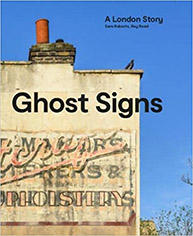Book Review. A guest post by LH Member Jane Parker.
_______________________________________________________
 At last. A book about London ghost signs. And just in time for Christmas.
At last. A book about London ghost signs. And just in time for Christmas.
This is a book for people who stare at brick walls trying to decipher hints of letterform on them. For those of you who aren’t familiar with the subject, ghost signs are the remnants of old signage still clinging on to the buildings that overlook today’s streets, telling us about the products and services that used to be available, mostly at or near to those locations.
This book focuses in the main on the ads that were hand-painted directly onto walls. Quite a few of us have been collecting this kind of bygone signage in photographic form for decades, getting excited as we discover a ‘new’ one on a backstreet that no-one else seems to have noticed. Such is the addiction here, as many old signs, having been exposed to the elements for decades may have faded considerably, leaving only hints of random letters that become intriguing puzzles, appealing to the sleuth and local historian alike. Other signs are suddenly revealed after being hidden, and therefore protected, by subsequent advertising methods, such as frames designed to accommodate multi-sheet posters and, later, back-lit boxes and moving images.
Sam and Roy have, in the most part, here concentrated on the signs visible to at time of press and, as such, the book is document of now; a moment in time and many of the ads included here may well have been lost to us in the last few months, covered by paint, obscured by other buildings, or reduced to rubble when the host building was demolished.
Some of the most colourful and best-designed examples of this old type of artisan-created signage were for the big brands of the day such as those selling soap, razors, matches and beer. These are well-represented in ‘Ghost Signs; A London Story’ with an excellent cross-section of examples accompanied by information about the companies who made the products, how the sites were purchased and managed, and how the signs were designed and executed. Much is also written about preservation, restoration and maintenance, which makes for a provocative discussion.
The book also showcases a marvellous selection of some of London’s independent local traders making good use of high walls and sight lines to advertise their wares or services. These are possibly the most interesting to historians, with products from pianos, mourning coats and sanitary ware to carriages, landaus and leather goods, offering a window into a specific era or location.
The photography and information in all respects are good with lots of cross-referencing, although it has to be said that the images and the font sizes for the captions and indexes could have been larger. That aside, it’s a fabulous resource to dip into and be inspired by, or to refer to after spotting a ghost sign yourself, as you too are sure to start noticing hints of old painted signs after reading this, and you might even find one that is not mentioned. Due to the ever-changing subject matter here, this is bound to be the first of many updated editions.
Ghost Signs: A London Story (320pp) by Sam Roberts and Roy Reed is published by Isola Press.
Leave a comment